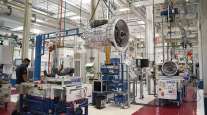Manufacturing Holds at Weakest Pace of Growth Since 2013

Manufacturing in April held at the weakest pace in almost two years, prompting factories to pull back on hiring as they await stronger demand in the United States and abroad.
The Institute for Supply Management’s index was unchanged at 51.5, the lowest since May 2013, a report from the Tempe, Arizona-based group showed May 1. Readings above 50 signal expansion, and the April figure was less than the median projection of 52 in a Bloomberg News survey of economists.
The lack of improvement reflects the lingering effects of a stronger dollar and low oil prices on capital spending and exports that caused the economy to nearly stall in the first quarter. While the ISM’s report showed factory employment was the weakest since 2009, readings on orders and production advanced as goods began to move after labor-related delays at West Coast ports.
“For the most part, the rebound may not be as strong as people are expecting,” Gennadiy Goldberg, a strategist at TD Securities in New York, said before the report. “There currently are considerable downside risks to the second quarter.”
Estimates of 85 economists in the Bloomberg survey ranged from 50.3 to 54. Readings greater than 50 indicate growth.
Global manufacturing remains tepid. Growth at U.K. factories dropped to a seven-month low in April, according to a Markit Economics Ltd. index. China’s official Purchasing Managers’ Index was little changed at 50.1 last month, the China Federation of Logistics and Purchasing in Beijing said April 30.
ISM’s measure of U.S. factory employment decreased to 48.3, the weakest since September 2009, from the prior month’s 50 reading.
The group’s new orders gauge climbed to a four-month high of 53.5 from 51.8, and a measure of production rose to 56 from 53.8. The index for orders waiting to be filled held at 49.5.
The measure of export demand rose to 51.5 last month from 47.5 in March. The report also showed the index of prices paid increased to 40.5 from 39.
The advance in the dollar since mid-2014 and the global drop in oil prices have taken a toll on investment and export demand, which had fallen for four consecutive months through February.
A wider trade deficit subtracted 1.25 percentage points from first-quarter economic growth. Gross domestic product, the volume of all goods and services produced, rose at a 0.2% annualized rate, the weakest in a year, after advancing 2.2% in the prior three months, according to Commerce Department data released April 29.
Corporate fixed investment decreased at a 2.5% annualized pace, the worst performance since the end of 2009, the GDP figures also showed. Investment in nonresidential structures, including office buildings and factories, dropped by the most in four years, reflecting weakness in petroleum exploration.
Halliburton Co., the world’s second-biggest provider of oil field services, said it expects to reduce capital spending by 15% this year and accelerated the pace of job cuts ahead of its takeover of Baker Hughes Inc.
That’s one reason Federal Reserve officials signaled this week after a two-day meeting that they’re in no rush to begin raising interest rates.
At the same time, there are signs household demand is improving. Consumer spending climbed in March by the most since November, helping to end a weak first quarter on a more hopeful note. A strong labor market and some improvement in wages may help usher in a U.S. rebound.
Economic growth may pick up to a 3.1% pace in the second quarter, according to the median forecast in a Bloomberg survey conducted April 3-8. For all of 2015, the economy is projected to expand 2.9% on average.
Automobile sales are holding up. Honeywell International Inc., a Morris Township, New Jersey-based manufacturer, sees greater demand for its turbocharger technology as vehicle purchases rise.
“Lower prices at the pump, improvements in employment and overall positive consumer sentiment have driven greater demand for autos,” Chief Financial Officer Thomas Szlosek said on an April 17 earnings call.




